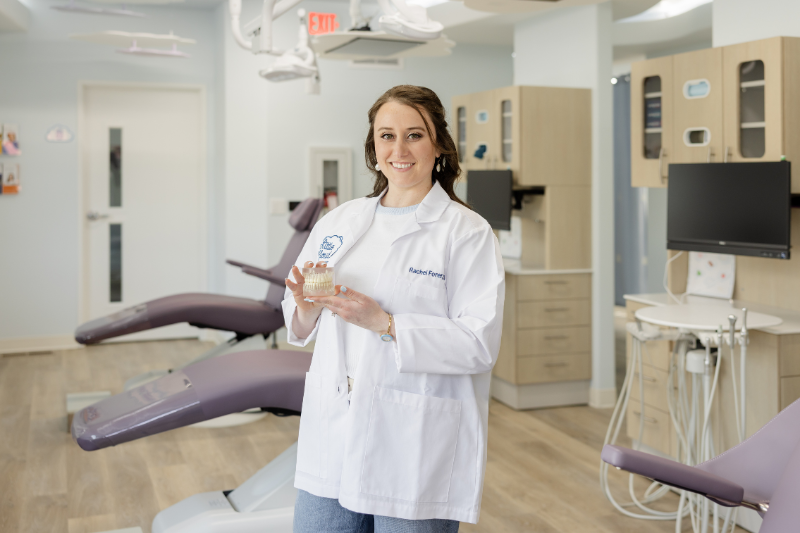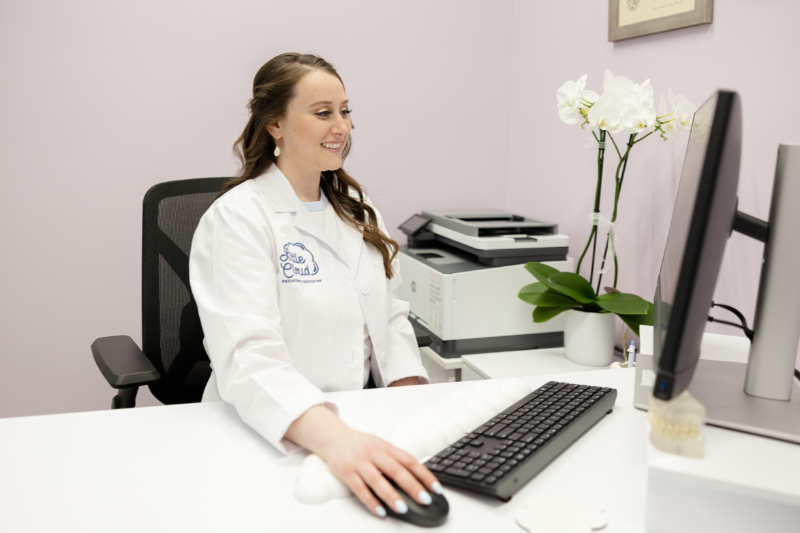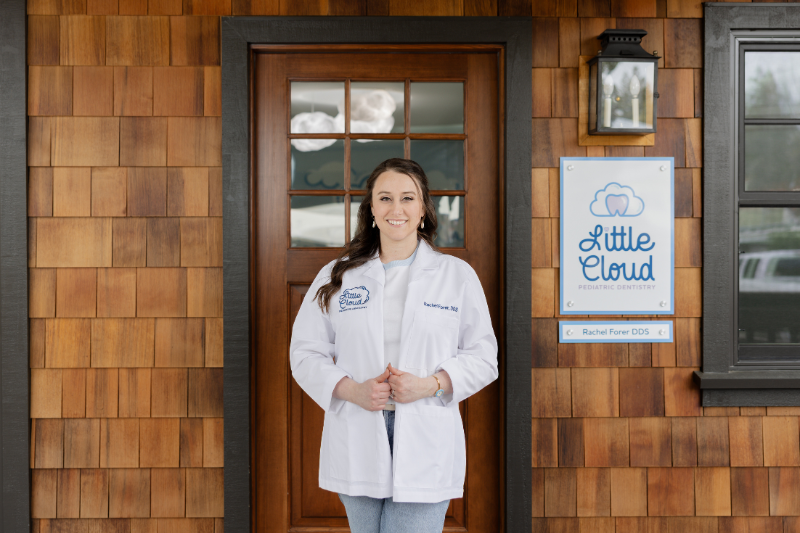Little Cloud Smiles: How Dr. Rachel Forer Is Redefining Pediatric Dentistry
Interview by Heather Anderson
When Dr. Rachel Forer opened Little Cloud Pediatric Dentistry in Lafayette, she had one mission: to make kids love going to the dentist. With her “land cloud” Samoyed therapy dogs, a ceiling mural filled with hidden shapes, a prize gumball machine, and a light, welcoming vibe, she’s proving that dental visits can be something children actually look forward to.
Rachel’s story starts with her own childhood dental experiences, where strong female role models helped spark her dream to pursue dentistry. Today, she’s blending top-tier credentials (UCSF residency, board certification, hospital privileges) with a playful, family-friendly practice designed to put kids and parents at ease.
You’ve shared that your own childhood dental experiences were so positive they inspired you to become a dentist. Can you tell us about those early memories—and how they shaped the way you now approach kids in your own practice?
I knew I wanted to be a dentist at seven years old. I had orthodontic work early, and I loved watching how my smile changed over time. My orthodontist did everything himself, which fascinated me, and my general dentist—who happened to be a woman—was equally wonderful. She gave me such positive experiences that I shadowed her as a teenager and later worked in her practice.
She even came to the grand opening of Little Cloud Pediatric Dentistry, which was so special. Having those role models, especially women, really showed me the kind of dentist I wanted to be—hands-on, approachable, and inspiring to the next generation.
I started as a general dentist, but after hearing so many adult patients share their fears, I realized most of that fear stemmed from childhood. That’s when I decided to specialize in pediatrics—because if I could help shape positive dental experiences early, those kids would grow up to be adults who aren’t afraid of the dentist.
You opened Little Cloud Pediatric Dentistry less than a year ago, and kids are already coming back excited for their six-month visits. What does that feel like?
Honestly, it brings tears to my eyes. It’s exactly why I created this practice—to make the dentist feel like a happy place.
Part of it is the environment: TVs on the ceiling, a toothpaste “flavor menu,” prizes in a gumball machine, and even a giant Lite-Brite wall. But more than that, it’s the atmosphere we’ve cultivated. My team is warm and caring, and we treat families like part of our own. Those little details add up to a big difference in how kids feel.
Not every pediatric dentist has therapy dogs in the office. Why was it important to you to bring Pearl and Onyx into your practice?
Pearl is our COVID baby, and she’s always been amazing with kids. I’d long dreamed of having her certified as a therapy dog, and when I opened Little Cloud, I knew she had to be part of it.
Animal-assisted therapy is actually backed by research and included in the American Academy of Pediatric Dentistry guidelines for behavior management. Pearl has made a huge impact—one little girl who’d struggled with anxiety at her old office came here, bonded with Pearl, and ended up volunteering for X-rays she’d previously refused. Her mom cried, I cried…it was incredible.
Onyx, our younger Samoyed, is still in training, but he’s getting there. They’re also the inspiration for our whole practice theme. Samoyeds are called “land clouds,” and we even have a ceiling mural painted with hidden shapes for kids to find. Families love it—it makes the experience feel magical.
A lot of parents quietly admit they feel guilty or anxious—worried they’ve waited too long for a first visit, or that pacifiers or skipped brushing might have “ruined” their child’s teeth. What do you say to reassure them?
First, I always tell parents: you can’t change the past, but you are here now, and that matters. Life is busy, parenting is hard, and there’s no room for shame in my office.
Cavities can happen whether you’re super diligent or not, and we’re here to help, not judge. I’ve seen children come in for their first dental visit at one year old, and others not until age eight—it’s never too late to start fresh.
“...if I could help shape positive dental experiences early, those kids would grow up to be adults who aren’t afraid of the dentist.”
Your office is especially supportive of kids who are neurodivergent or have dental phobias. How do you make those appointments calmer and more positive?
We start with a detailed questionnaire so parents can tell us what works best for their child—what helps, what triggers them, and what comforts them.
Our environment is intentionally calm: soft blues, no overstimulating décor. We’re flexible, too—kids can sit up, stay on a parent’s lap, or even brush their own teeth while I watch. It’s not one-size-fits-all.
I also offer desensitization appointments. Sometimes a child just comes in to put the chair up and down or look around the room. No cleaning, no pressure—just exposure. The first one’s complimentary, because I really believe it helps build trust for the long run.
What are some of the most common myths or misconceptions you hear from parents about baby and toddler teeth?
The biggest one is “they don’t matter—they’ll just fall out anyway.”
But baby teeth matter for everything: speech development, eating, guiding permanent teeth, and holding space in the mouth. Infections can cause pain, swelling, even hospital visits. Oral health is directly linked to overall health—it’s all connected.
When do you recommend scheduling that very first dental visit, and what can families expect?
Our professional guidelines say “first visit by one”—easy to remember as “first tooth, first birthday, first visit.”
That first appointment is mostly education. We talk about diet, brushing, teething, pacifiers, thumb-sucking, all the things parents worry about. Then we do a gentle exam and cleaning, plus a fluoride treatment.
We use a “knee-to-knee” method where the parent and I sit facing each other with the child lying across both our laps. It’s safe, effective, and helps parents learn techniques they can use at home.
And even if the baby fusses—that’s okay. I always tell parents, brushing and flossing are like car seats. Even if kids resist, safety comes first.
Insurance can be overwhelming for families. How do you help parents navigate that?
Insurance is complicated, and every plan is different. We’re upfront about what we accept, and I work hard to explain options clearly.
For families whose plans we don’t accept, I still try to guide them. We offer a membership plan and financing for bigger procedures, and I’ve even personally emailed parents about their coverage to make sure they understand.
At the end of the day, I know I won’t be every family’s dentist, but I want parents to feel supported and informed when making decisions.
What if a child is older and switching practices? How do you make that transition smooth?
It’s really simple. Parents just tell us who their previous dentist was, and we handle the rest. Sometimes a release form is needed to get records, but often we take fresh X-rays and start new.
The important thing is that families have the right to choose the dentist that feels best for them. Switching isn’t complicated—it just takes a phone call.
You balance impressive credentials with such a warm, family-friendly vibe. How do you bring those two worlds together?
I’m detail-oriented, and I go the extra mile for families. Whether that means coordinating with UCSF, arranging hospital privileges, or creating a calming environment for a child with special needs, I want every parent to feel their child is truly cared for.
I treat families the way I’d want mine to be treated. It’s as simple as that.
Before dentistry, you were a member of UC Davis’ all-female a cappella group, The Spokes. What was that like—and do you ever bring that energy into your work today?
It was very Pitch Perfect! We traveled, held big concerts, and it was such a fun, creative outlet.
I still sing for my patients sometimes. During residency, before we had TVs, I used songs from Encanto—“We Don’t Talk About Bruno” was perfect for distracting kids and keeping track of time during a visit. Music is playful, and that energy translates beautifully into working with children.
(And yes—you can still find recordings of me singing lead with The Spokes!)
Your office is right next door to Five Little Monkeys, one of our favorite local toy stores—and I heard you even teamed up with them. What’s that about?
It really is a match made in heaven. We give new patients a gift card to Five Little Monkeys at the end of their visit. It creates another positive association: you go to the dentist, then you get to visit the toy store!
We also do giveaways and collaborations together. Supporting other small, local businesses is really important to me, so this partnership just feels natural.
At the end of the day, what’s the most important thing you want parents to remember about their kids’ teeth?
That it’s never too late to start, and that dental visits can be positive. Even if you had tough experiences as a child, you can give your kids a fresh start. We really do things differently now.
Want to see for yourself what makes Little Cloud Smiles special?
Book your child’s first appointment: Little Cloud Pediatric Dentistry Website
Meet Pearl and Onyx, our “land cloud” therapy dogs, on Instagram: @littlecloudsmiles
Visit us in Lafayette and make a stop at Five Little Monkeys toy store right next door!
Connect with Dr. Rachel Forer on Facebook.
You can also find her on The M List, The Mamahood’s searchable database of mom-recommended resources, or connect and collaborate with Dr. Forer inside The Club membership for women Founders.




